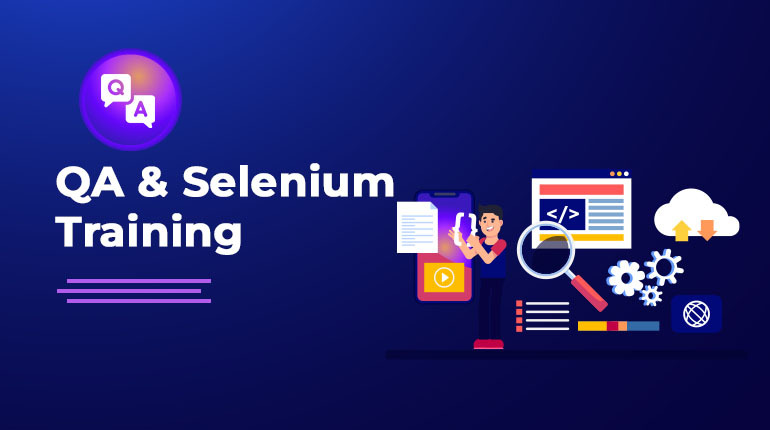Selenium Certification Training

Selenium Training
Learn from industry experts and SMEs to become certified with this Selenium course. This Selenium Certification Training course aids in the thorough understanding of ideas like Selenium Grid, WebDriver, TestNG, Wait, Locating Techniques, AutoIT, Sikuli, Page Object Design Pattern, and WebDriver. In order to teach you how to utilize Selenium WebDriver successfully, this training program includes real-world examples, hands-on projects, and case studies.
Key Features of Selenium Course
- Benefits of Selenium automated testing
- Selenium RC Deploying Selenium IDE commands and functions
- Sikuli, JUnit, the TestNG plugin in the Eclipse Object repository, and Maven
- Introduction to Selenium WebDriver Training programs for Selenium WebDriver with Textbox, Checkbox, and Multiple Windows
- Software automation testing with Selenium Grid
- Get Selenium Certificate
- Flexible Schedule
- One on One sessions
- Hands-on experience with demo web testing
- Self-paced learning material
- Job assistance
Who should take this course?
For those who wish to study automation testing with Selenium, test managers, test engineers, test lead, test analysts, quality assurance engineers, software developers, and engineers should enroll in the Selenium Certification Training.
Benefits of Selenium Automation
According to Indeed, Selenium is one of the most widely used automation testing tools and is being utilized by enterprises all around the world. These careers often have high yearly wages, ranging from $68,000 for quality assurance analyst positions to $94,000 for duties like automation engineers.
Pre-requisites
It is advantageous but not necessary to have some familiarity with C or Java in order to enroll in this Selenium certification program.
Selenium 3.0 Training
- Lesson 01 - Core Java Refresher
- 1.1 Keywords and Syntax
- 1.2 variables, operators, and control flows
- 1.3 OOPs overview from Java context
- 1.4 Exception Handling, File and DB handling
- 1.5 Collections overview, and ArrayList example
- Lesson 02 - Automation Basics
- 2.1 Fundamentals of test automation
- 2.2 ROI in Automation
- 2.3 Automation framework
- 2.4 Various tools and comparison with Selenium
- Leson 03 - Introduction to Selenium WebDriver
- 3.1 What Selenium is and how it is used in the industry
- 3.2 Features of Selenium
- 3.3 Selenium IDE - Overview with a couple of examples
- 3.4 WebDriver Architecture
- 3.5 Installation of Selenium and supporting tools/Frameworks
- Lesson 04 - Locating Techniques
- 4.1 Simple WebDriver Program Demonstration
- 4.2 Basics of HTML page, tags, attributes, and visible texts
- 4.3 Importance of attributes in locating elements
- 4.4 Installation of Firebug and Firepath in Firefox browser
- 4.5 Locators and Eight Locating Techniques
- 4.6 Creating robust locators using CSS and XPath
- Lesson 05 - WebDriver Basics - I
- 5.1 Execute Tests in Firefox, Chrome, and Internet Explorer
- 5.2 WebDriver Commands: Driving Browsers and Handling Cookies
- 5.3 WebElement Commands
- 5.4 Handling Various WebElements
- 5.5 WebDriver Timeout Methods
- Lesson 06 - WebDriver Basics - II
- 6.1 Handling Multiple elements using findElements() method
- 6.2 Handling Alerts, Pop-ups, and Frames
- 6.3 Limitation of Implicit Wait and how Explicit Wait helps
- 6.4 Advanced User Interactions
- 6.5 Taking Screenshots
- 6.6 Working with Firefox profiles
- 6.7 Handling File Uploads Using AutoIT
- 6.8 Introduction to Flash Application Testing using Selenium WebDriver
- Lesson 07 - TestNG
- 7.1 Arranging Tests in 3-As format
- 7.2 F.I.R.S.T Principles and SRP
- 7.3 Various Annotations in TestNG
- 7.4 TestNG configuration file
- 7.5 Configuration Annotations
- 7.6 Attributes of @Test
- 7.7 Parallel Test Execution Capability
- 7.8 Assertion APIs
- 7.9 Passing Parameters to Tests
- 7.10 Configuring Test Suites
- 7.11 Reports using TestNG
- 7.12 Reports using ReportNG
- Lesson 08 - WebDriver - Framework
- 8.1 Introduction to various frameworks
- 8.2 Page Object Design Pattern
- 8.3 Data Driven Tests using TestNG and POI
- 8.4 Introduction to Maven and ANT
- 8.5 Use of Log4j
- 8.6 Use of Listeners
- 8.7 Typical components of a framework
- 8.8 Overview of BDD, TDD
- 8.9 Code Coverage in Java
- 8.10 Overview of Sikuli tool for UI testing
- 8.11 Introduction to Jenkins
- 8.12 Configuring Jenkins to invoke Selenium Tests
- Lesson 09 - Selenium Grid
- 9.1 What is Selenium Grid?
- 9.2 When to Use Selenium Grid
- 9.3 Setting up Grid - Hub and Nodes?
- 9.4 Configuring TestNG.xml to run tests on Grid
- Lesson 10 - Project Execution
- 10.1 Automate an eCommerce Application
- 10.2 Test Automation Requirements Description
- 10.3 What Next ? How to Start?
- 10.4 High-Level Framework
- 10.5 Configurability—No To Hard-Coding
- 10.6 Modularity—Re-Use And DRY
- 10.7 Test Data Management
- 10.8 Logging And Reporting
- Lesson 11 - Mobile App Test Automation Using Appium
- 11.1 Introduction Mobile App Test Automation
- 11.2 Introduction to Appium
- 11.3 UIAutomator with Appium
- 11.4 Locating Elements - UIAutomator framework
- 11.5 DesiredCapabilities for Android
- Lesson 01 - Core Java Refresher
Selenium Certification Training FAQ’s:
ETL testing refers to the process of validating, verifying, and qualifying data while preventing duplicate records and data loss. The process of ETL testing includes verification that data has been successfully extracted from the source system, transformed into the required format, and then loaded into the final destination.
ETL testing is unique in that it focuses on the data itself rather than the functionality of the code. Unit testing looks at small pieces of code (units) to make sure they are working as intended, while integration testing ensures that those units work together seamlessly. Regression testing is repeated unit or integration testing to make sure there are no negative effects from new changes.
A common use case for ETL testing is data migration. ETL testing should be performed any time data is moved from one system to another, to ensure that the data has been extracted correctly, transformed into the correct format, and loaded into the new system without any errors.
The ETL Testing process can be broken down into three steps The Extract/Transform/Load process consists
The most important task of an ETL tester is to verify that the data has been extracted correctly from the source system, transformed as required, and then loaded into the target system without any errors. In addition, ETL testers also need to ensure that there is no data loss during the extraction, transformation, and loading process. They also need to verify that all the data from the source system has been successfully transferred to the target system and that the data in the target system is consistent with the data in the source system.
Absolutely! Salesforce offers a variety of free resources designed to help students learn about and succeed in the field of sales. From e-books and articles to webinars and online courses, Salesforce has everything you need to get started in your studies.
ETL tools available on the market include: Informatica PowerCenter, Oracle Data Integrator, IBM InfoSphere DataStage, Microsoft SQL Server Integration Services and Pentaho Data Integration.
